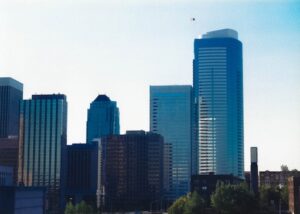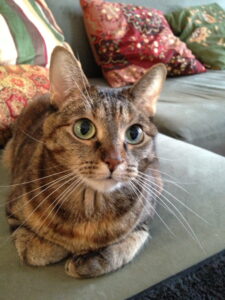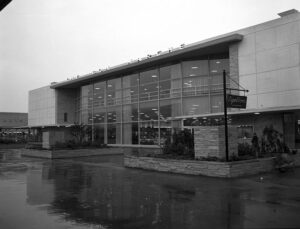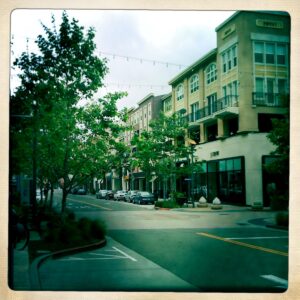 I saw a doc on Netflix the other night called How to Rob a Bank. It’s about Scott Scurlock, a bank robber who had a big run in Seattle in the mid-90s, hitting 18 (or 19) banks for a bit over $2M in 1990s money. It was a pretty generic doc, but had lots of footage of 1992 and 1993 Seattle that really brought me back.
I saw a doc on Netflix the other night called How to Rob a Bank. It’s about Scott Scurlock, a bank robber who had a big run in Seattle in the mid-90s, hitting 18 (or 19) banks for a bit over $2M in 1990s money. It was a pretty generic doc, but had lots of footage of 1992 and 1993 Seattle that really brought me back.
I lived in Seattle starting in 1995, and the film ends in 1996. I honestly have no memory of this news story, but I didn’t have a TV or cable back then, and didn’t read a newspaper, so I totally missed it. But the stock footage, the establishing shots they used, that totally brought me back. It all looked like it was shot on a Hi8 camera, both a crummy quality but a way-too-bright color palette that makes it look far too sharp and vivid. I think I got a Sony Hi8 right around the time of the end of this movie – maybe the same month – and I regret not walking around Pioneer Square and shooting hours and hours of footage of everything and nothing.
Scurlock, aka “Hollywood,” habitually hit Seafirst bank, which was my bank. When I got my first real paycheck in 1995, I went downstairs from our office and walked in a Seafirst on Occidental and opened a checking and savings account. I got a special deal which was new back then: no monthly fees or minimum balance, but I had to pay to talk to a human. I could call their voice mail thing to hear my balance or make a transfer (this was before web banking), and I could use the ATMs or drop off a check. But for an introvert who hated lines, this was the perfect deal.
It also meant I was never standing in a bank lobby when a dude with a rubber nose and chin glued to his face jumped on a counter, waved around a Glock 17, and started screaming for the vault teller. This was a good feature to have, since Scurlock and crew used to repeatedly hit the Seafirst on Madison about a mile from my house, across the street from this classic red-roof Pizza Hut I would always visit when I needed a quick case of nostalgia and/or diarrhea.
The movie built up Hollywood to be this Robin Hood type who lived a vagabond lifestyle, traveling worldwide, living in a treehouse in the woods, writing poetry in his journals. What’s weird to me is he looked like someone I might know, like a friend of a friend of someone who went to Evergreen to study vegan architecture. He had this longish but not long hair, used to be a nudist and live in the woods near Olympia, but wasn’t like a hippy hippy. He seemed more like a weird libertarian guy who was a UNIX system administrator at Boeing and spent a lot of time on bondage groups in USENET news. I never really hung out with anyone like that, and he was a half-generation older than me, but I spent enough time in Belltown that I knew the type.
And I’m not saying I’m into a guy like this, but one of the reasons I’ve never gone back to Seattle is I’m sure Amazon has completely homogenized it, and the weirdo underbelly has all died out or sold out. I’m sure if I went to a cafe in Fremont now, it would all be people talking about crypto or keto muffins or crossfit. In 1996, it would have been dudes in 79 different garage bands, perennially only two connections from making it. Like your refrigerator delivery guy was in a band that would share a practice space with an iteration of a band that split and half the members went to the first version of Lords of the Wasteland that later had a second iteration that became Mother Love Bone that became Luv C2 that became Mookie Blaylock that changed their name to Pearl Jam. Anyway.
It was also funny to see the doc throw in a quick grunge reference, even though Scurlock was probably totally unrelated to that scene. They spent about 90 seconds showing those crazy flannel kids, playing some unrecognizable music the film could clear without paying the Nirvana estate seven figures. “Hey, these kids hate corporate rock! They’re rebels! It’s the spirit up here!” Sigh.
Spoiler alert, Hollywood tried to go out big with a giant heist, and ended up in a firefight and chase, then killed himself before the cops could. It was on Thanksgiving in 1996. I was trying to remember where I was that Thanksgiving, and the funny thing is, I remember exactly where I was that day, because it’s one of my funniest meet-the-parents stories. I’ve always been hesitant to write about this publicly, but this was almost thirty years ago, and I have not talked to her in 25, so here goes.
I used to date someone who lived in a small town in Southwest Washington, a hundred miles south of Seattle, just before the Oregon border. This started in October, and we’d been trading off weekends, one of us driving to see the other. And Thanksgiving became the “let’s have dinner with my parents” weekend down there.
I’m always nervous in these situations, and this one was slightly amplified because she said her parents were very religious and pretty conservative, and I’m neither. We got there and they lived in a second-story walk-up at this boarding school where her dad worked, like a staff housing thing. Her dad was really nice, and the dinner was great, and I mumbled through saying grace, and then I answered the usual questions. Her mom was okay but sort of quiet, fair enough. She had two older brothers and they were cool, although I knew nothing about sports and sports was like their entire lives. I’d need to memorize some stats or figure out the name of the baseball team that played across the street from my apartment before I saw them again. (“Hey that Kevin Griffey guy, he’s like, pretty good, right?”)
After dinner, I got the big curve ball: her parents were moving. Tomorrow. And nothing was packed, and the house was crammed with decades of stuff and all the fixins from a big turkey dinner and a bunch of appliances that were going with them. And it was a second-floor walk-up. No elevator. And it all had to be moved and the apartment cleaned that Friday.
I’ve moved a bunch and I’ve helped people move, and I’ve been in some disorganized situations, but this was the most chaos I’d ever seen in this kind of operation. It’s impossible to help someone pack their stuff into boxes when you’ve known them a grand total of 37 minutes and you have no idea what is trash and what is treasure and there’s piles of stuff going back to like 1976. Hauling a fridge, a chest freezer, a stove a dishwasher, and a washer and drier down a set of exterior stairs was bad enough. But packing in all the assorted bric-a-brac was torture. They had a big U-Haul, like a 24-foot thing, and I think we filled it twice, plus a bunch of carloads of stuff.
They bought a new pre-manufactured home in a retirement community, which was pretty nice, although it made me wonder how much of it was assembled on a line in Elkhart. We got all the boxes off the truck, then realized the truck was parked in the yard in a small lake, except the lake was slowly getting bigger? We took a look and one of the sets of tires was parked directly over some main water connection to the entire little village, and had cracked it open. So their “Welcome, neighbors!” was getting everyone’s water shut off during Thanksgiving weekend. Fun stuff.
Anyway. Movie review concluded. Check out my Substack. Have a nice day.




